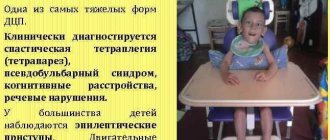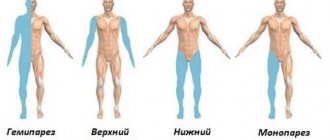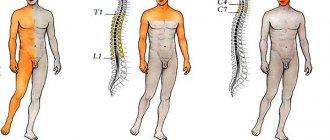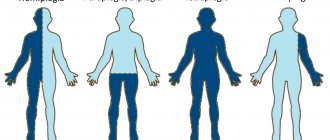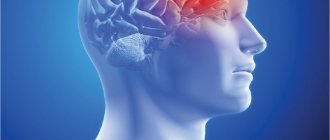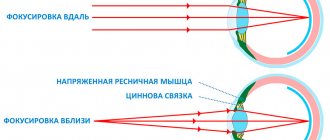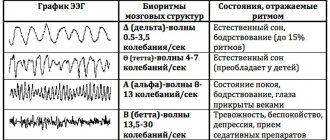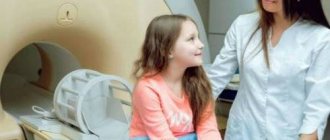Causes
Neurologists believe that the main reason for the development of spastic tetraplegia in the case of premature babies is perinatal hypoxia.
Doctor Nikonov
Under an electron microscope, a photo of a spastic muscle shows that the number of vessels in it has decreased due to swelling. That is, there is hypoxia, but not in the brain, but in swollen spastic muscles.
Neurologists believe that the main reason for the development of spastic tetraplegia in full-term infants is neuronal necrosis during intrauterine chronic hypoxia.
Doctor Nikonov
Ultrasound and MRI do not show neuronal necrosis. Data on necrosis are taken tentatively. There is no evidence of neuronal necrosis. There is evidence of swelling in the muscles - visible under an electron microscope .
Neurologists believe that the cause of spastic tetraparesis is a toxic factor: alcohol, smoking, taking potent medications.
Doctor Nikonov
The fetus is in the placenta. Nature has made it so that the placenta acts as a filter. All the substances carried by the blood settle on its walls. The placenta does not allow nicotine and potent substances to pass through.
Regarding alcohol: Professor S.V. Savelyev of the Russian Academy of Sciences proved that the human body produces alcohol for food. The amount of alcohol produced by the human body tells the neurons of the brain about the amount of food eaten. Professor Savelyev S.V. proved that alcohol does not disrupt the development of brain neurons in the fetus. That is, this is another invention of neurologists .
Neurologists believe that the cause of double hemiplegia (spastic tetraparesis) is physical impact. Brain damage can occur due to radioactive, x-ray irradiation of a pregnant woman, as well as as a result of electromagnetic treatment.
Doctor Nikonov
Ultrasound and MRI do not show damage to brain neurons. These physical factors can increase muscle swelling The result of these physical factors is a disease of the muscles, but not the brain .
Neurologists believe that mechanical causes can cause brain damage. Mechanical damage includes injuries and damage immediately after birth.
Doctor Nikonov
Neurons can be damaged not by a blow, but by a hemorrhage in the brain. Professor Savelyev S.V. claims that the brain cleanses itself of dead neurons in three months. Dead neurons are not restored. There may be a million dead neurons, but there are trillions of neurons in total. These millions do not affect the functioning of the brain. The brain completely restores lost connections between neurons in six months .
If the brain has restored connections in six months, then spastic tetraparesis should disappear after six months, but this does not happen. On the contrary, the brain improves its function, and clinical manifestations in children with spastic tetraparesis worsen.
Reasons for the development of diplegia
In neurology, there are 3 main factors for the onset of the disease:
- Prematurity . Early birth occurs due to Rh conflict between mother and fetus, early placental abruption, uterine disease and causes brain damage during intrauterine development.
- Trauma during childbirth. Complicated childbirth occurs due to intrauterine pathology or medical error.
- Hypoxia or asphyxia. Lack of oxygen during childbirth or during intrauterine development leads to brain damage.
Symptoms
Now I will inform you about the symptoms of spastic tetraparesis , which you know about when you see your child.
With double hemiplegia it is diagnosed:
- spastic quadriplegia;
- visual impairment;
- cognitive and speech disorders;
- Epileptic seizures are possible.
Doctor Nikonov
I would like to add about epileptic seizures. They begin against the background of drug treatment with drugs that excite brain cells . As soon as epileptic seizures begin, doctors prescribe medications that inhibit the brain .
In the spastic tetraparesis form of cerebral palsy, early formation of limitation of passive movements, deformations of the limbs and trunk is observed.
Doctor Nikonov
There is no bone deformation. The appearance of deformation is created by swollen muscles.
The presented video is not educational. The video is the result of the work. Repeating procedure techniques without training from Dr. Nikonov may result in serious injury.
Subscribe to channels
Clinic channel
Personal channel
Subscribe to channels
Clinic channel
Personal channel
Children with spastic tetraparesis (double hemiplegia) have strabismus, optic nerve atrophy, and hearing impairment.
Spastic tetraparesis has two forms : spastic tetraparesis and lower paraparesis.
Neurologists explain that spasticity is “a movement disorder that is part of the upper motor neuron syndrome, characterized by a speed-dependent increase in muscle tone and accompanied by increased tendon reflexes as a result of hyperexcitability of stretch receptors.”
In spastic tetraparesis, movement disorders are associated not only with high tone, but also mainly with a reciprocal decrease in the activity of the phasic system against its background. Subsequently, as the child grows, the influence of unreduced tonic reflexes leads to deformation of the structures of the musculoskeletal system; the feet are the first to be affected. Further development of deformities leads to the impossibility of developing upright posture, which leads to increased pathologies.
An interesting fact is that such symptoms do not develop with the development of diseases of the nervous system at a later age. With cerebral palsy, in contrast to central spastic paralysis, abnormal tonic and phasic reactions are observed that interfere with the implementation of motor function or deform it.
Spastic tetraparesis is accompanied by minor developmental anomalies, which are a consequence of intrauterine brain damage. At the age of 2-3 years, children develop symptoms of cerebellar damage, which is expressed in the inability to move independently, support the head, etc. In most cases, spastic tetraparesis is accompanied by intellectual impairment, the degree of which depends on the location of the brain lesion.
Doctor Nikonov
Under an electron microscope, swelling in the muscles, displacement of the nuclei, changes in mitochondria and an increase in the thickness of the connective tissue, in which the swelling is located as in a bag, are visible. Naturally, every year the swelling increases and the muscles swell more and more.
Any symptoms can be attributed, including damage to the cerebellum. But it is impossible to prove this, since the structure of the cerebellum is not physically damaged. Intelligence depends on the movement of the muscles of the hands and mouth. There are no movements in the arm muscles and the child does not speak or chew food - intellectual lag occurs naturally.
Manifestations of the disease: when, how and why
A child with cerebral palsy in the form of spastic tetraparesis suffers from damage to both arms and legs. The disease manifests itself as spasticity - a condition in which the muscles of the limbs contract frequently and strongly, but cannot relax on their own.
There are 5 levels of motor activity disorders:
- walks without restrictions;
- walks with restrictions;
- walking requires a cane, crutches, and walkers;
- a motorized wheelchair is required for independent movement;
- complete dependence on others.
Epilepsy is added to the symptoms of tetraplegia in every second child suffering from this form of cerebral palsy. There are frequent cases of impairment of intelligence, vision, hearing, and speech.
An experienced doctor can notice pronounced signs of cerebral palsy already in the first week of a newborn’s life, but the diagnosis is made much later. Therefore, at an early stage they talk about the risk of developing cerebral palsy, but they already begin to provide assistance to the baby.
Treatment of spastic tetraparesis
Since I myself, in my experience only one way to restore a child Working according to this method is a manual influence on swollen muscles with a certain fixation of the muscle with which the work is being done.
Neurologists believe that it is impossible to restore children with this diagnosis and propose treating spastic tetraparesis (double hemiplegia) with complex measures, including conservative, orthopedic and rehabilitation methods. The main goals of therapy are to eliminate the consequences of the disease such as spasticity, dysfunction of the musculoskeletal system, and abnormal movement patterns.
Conservative treatment includes drug therapy with Baclofen and Botulinum toxin, which reduce spasticity, increase impulse conductivity, and improve metabolism in the brain, which should result in an increase in passive movements in the limbs.
Doctor Nikonov
Conservative treatment does not increase passive movements, let alone active movements.
Neurologists offer physical therapy , which includes a set of exercises, poses and movements aimed at strengthening muscles.
Doctor Nikonov
How can you strengthen spastic muscles? Try to move them!
Neurologists use hirudotherapy, acupuncture, massage, physical therapy, and kinesiotherapy.
Doctor Nikonov
Only the appearance of recovery is created.
Neurologists offer surgical treatment for double hemiplegia. During the operation, the muscles are stretched and the contracture is corrected, and tendon plastic surgery is performed.
Doctor Nikonov
I have not seen a single child with spastic tetraparesis who became physically better after undergoing surgery.
Neurologists cannot normalize spastic muscles with tetraparesis, so they offer rehabilitation, which, from the doctors’ point of view, helps adapt the patient to living conditions. Rehabilitation measures include occupational therapy, classes with a speech therapist, aquatherapy, and hippotherapy.
The goal of occupational therapy , which uses play techniques, copying and holding techniques, is to develop fine motor skills of the hands and regulate movements. Classes with a speech therapist can eliminate speech disorders and eliminate the problem of swallowing reflex disorder.
Aquatherapy helps relieve pain by relaxing spastic areas and helps strengthen muscles. During hippotherapy , a sick child is placed on a horse, which helps stimulate motor reflexes.
Doctor Nikonov
Spastic muscles in spastic tetraparesis do not move due to swelling. While the muscle is swollen, it will not move either on a horse, or in the pool, or with a speech therapist.
Clinical signs
The incidence of this form of cerebral palsy is 2%.
of the musculoskeletal system include:
Bilateral spasticity, expressed equally in both the upper and lower extremities (spastic quadriplegia or quadriparesis). Please note that there are forms when spasticity predominates only on the hands. With spastic tetraparesis, secondary complications develop early, such as contractures, deformities of the trunk and limbs. Pathological hand and foot reflexes are detected.
Disorders of mental and speech development , pathologies of the sensory organs:
In this case, severe cognitive impairment. Strabismus, optic nerve atrophy, hearing impairment, pseudobulbar syndrome and, as a result, dysarthria, dysphagia, dysphonia. In children with double hemiplegia, speech is usually slurred, nasal and difficult to understand by others. Incorrect pronunciation of sounds is often noted. The pace of speech has changed. The child pronounces words and sounds both excessively loudly, quickly, and weakly, slowly. Thinking in the most complex form of cerebral palsy is slow, inert, and memory is weakened. Disinhibition, euphoria, and apathetic-abulic disorders are often observed.
Other pathologies: epilepsy, secondary microcephaly.
Decrease in intelligence : pronounced.
Forecast
A quarter of those suffering from spastic diplegia walk independently, half move with crutches or canes. In case of severe tetraparesis, the person moves in a wheelchair. If there is no mental retardation and strong changes in the arm muscles, then the patients are socially adapted. In severe cases, the patient needs constant care. Regular and proper rehabilitation therapy in combination with a course of medications improves the prognosis.
Rehabilitation
We specialize in the treatment of cerebral palsy. We use traditional therapy in combination with progressive techniques. We are working on restoring lost skills and instilling new ones that the child did not have. We help you adapt to society and living conditions.
To sign up for a rehabilitation course, send to our email [email protected] your medical history and a story in your own words about the child’s condition. After this, we will issue an invoice with a list of procedures. If you have any questions, please call the contact number.
“Sakura” accepts patients from all regions of the country: Moscow, St. Petersburg, Yekaterinburg, Chelyabinsk, Novosibirsk, Ufa, Kazan and others.
